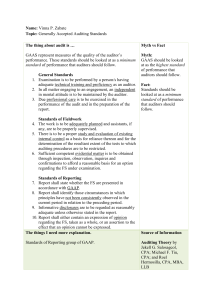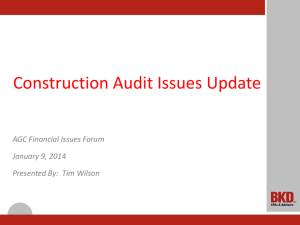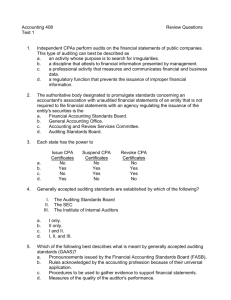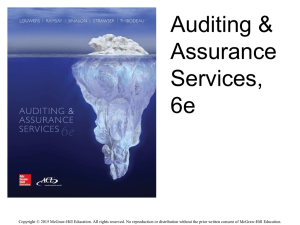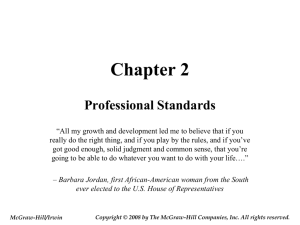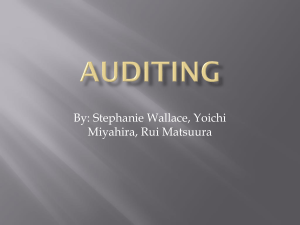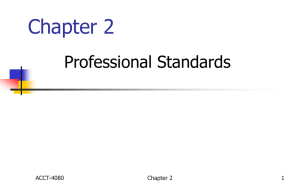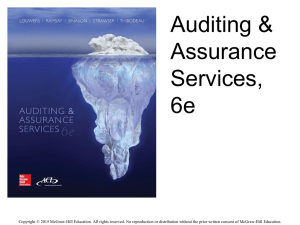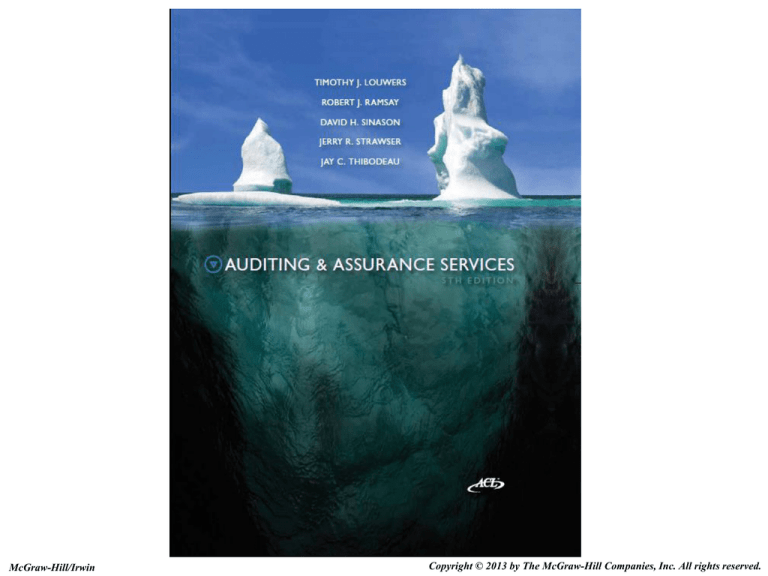
McGraw-Hill/Irwin
Copyright © 2013 by The McGraw-Hill Companies, Inc. All rights reserved.
Chapter 02
Professional Standards
“In today’s regulatory environment, it’s virtually impossible to
violate rules.”
– Bernard Madoff, money manager, on October 12, 2007,
approximately one year prior to being arrested for embezzling $50
billion from investors in a Ponzi scheme.
2-2
Auditing Standards for Public
and Nonpublic Entities
Audits of
Public Entities
Audits of
Nonpublic Entities
AICPA Statements on
Auditing Standards
Standards issued by the
Auditing Standards Board
prior to April 2003 not
amended or superseded
by PCAOB standards
(Interim Standards)
All current standards
issued by Auditing
Standards Board
PCAOB Auditing
Standards
All current standards
issued by PCAOB
Not applicable
2-3
Generally Accepted Auditing
Standards
• Identify necessary qualifications and
characteristics of auditors and guide the
conduct of the audit
• Purpose of GAAS is to achieve the following
objectives of an audit examination
– Obtain reasonable assurance about whether
financial statements are free of material
misstatement
– Report on the financial statements and
communicate in accordance with auditor’s findings
2-4
Comparison of AICPA GAAS to
Principles: Responsibilities
General Standards
Responsibilities Principle
1. Training and proficiency
Auditors are responsible for:
2. Independence in mental attitude
3. Due professional care
•competence and capabilities
•ethical requirements (independence
and due care)
•professional skepticism and
professional judgment
2-5
Responsibilities Principle
1.
Competence and capabilities
– Experience and expertise
2. Independence
– Independence in fact vs. independence in appearance
– Financial and managerial relationships
3. Due care
–
Level of performance by reasonable auditor in similar
circumstances
4. Professional skepticism and judgment
–
Skepticism: Appropriate questioning and critical assessment of
evidence
–
Judgment: Application of training, knowledge, and experience
in making informed decisions during audit
2-6
Comparison of AICPA GAAS to
Principles: Performance
Standards of Field Work
Performance Principle
1. Planning and supervision
To obtain reasonable assurance:
2. Understanding of entity and
environment to assess risk of
material misstatement
3. Obtain sufficient appropriate
evidence
•Plan work and supervise assistants
•Determine and apply appropriate
materiality levels
•Identify and assess risks of material
misstatement
•Obtain sufficient appropriate evidence
2-7
Performance Principle
Goal is to provide reasonable assurance that financial statements do not
contain material misstatements
1. Planning and supervision
– Preparation of audit plan
2. Materiality
– Influences decisions of financial statement users
– Considered throughout the audit
3. Risk assessment
– Understand entity and environment (including internal control)
– Determine necessary effectiveness of substantive tests
4. Audit evidence
– Sufficient = quantity (How many transactions or components?)
– Appropriate = quality (What level of reliability needed? Source?)
2-8
Overview of Evidence
Detection Risk
Appropriateness (Quality of Evidence)
Relevance (What
Does Evidence Tell
the Auditor?)
Sufficiency (Quantity
of Evidence)
Reliability (Can the
Auditor Trust the
Evidence?)
2-9
Sufficient evidence
• Related to quantity (number of
transactions or components examined)
• Influenced by effectiveness of entity’s
internal control
Effective internal
control
Lower level of
control risk
Ineffective internal
control
Higher level of
control risk
Evaluate less evidence
Evaluate more evidence
2-10
Appropriate Evidence
• Relates to the quality of evidence
• Relevance: Does evidence address assertion(s)
of interest?
• Reliability: Source of evidence
–
–
–
–
–
Auditors’ direct personal knowledge
External documentary evidence
External-internal evidence
Internal documentary evidence
Verbal evidence
High
Low
2-11
Comparison of AICPA GAAS to
Principles: Reporting
Standards of Reporting
Reporting Principle
1. Financial statements in accordance
with GAAP
• Express an opinion or state that an
opinion cannot be expressed
2. GAAP applied consistently (only
report if not consistent)
• Opinion is based on conformity of
financial statements with applicable
financial reporting framework
3. Adequacy of disclosures (only
report if not adequate)
4. Express or disclaim an opinion
2-12
Reporting Principle
• Express an opinion (or indicate that an opinion
cannot be expressed) on entity’s financial
statements
• Assess financial statements against financial
reporting framework
–
–
Set of criteria used to determine the measurement,
recognition, presentation, and disclosure of material
items in the financial statements
Examples include GAAP, IFRS, or special purpose
framework
2-13
Types of Audit Opinions
• Unqualified
– F/S are in conformity with GAAP
• Qualified
– Except for limited items, F/S are in conformity with GAAP
– Can issue for GAAP departure and scope limitation
• Adverse
– F/S are not in conformity with GAAP
– Can issue for GAAP departure (more serious)
• Disclaimer
– Auditors do not express an opinion
– Can issue for scope limitation (more serious) or situation in which
auditor is not independent
2-14
System of Quality Control
• Provides firm with reasonable assurance that the firm and its
personnel
– Comply with professional standards and regulatory/legal
requirements
– Issue reports that are appropriate in the circumstances
• Reviewed through either peer reviews (for firms auditing
nonpublic entities) or PCAOB inspections (for firms
auditing public entities)
2-15

